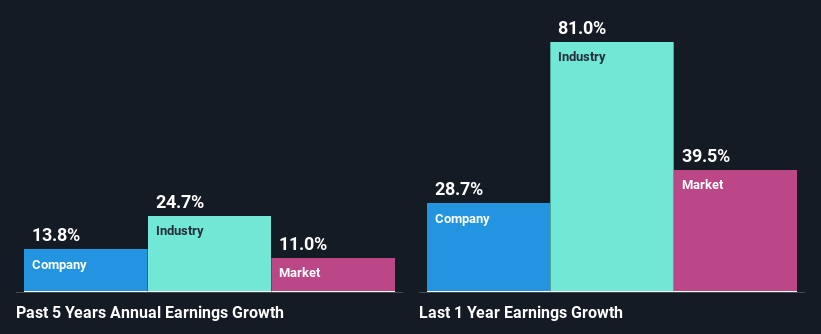Is PWR Holdings Limited's (ASX:PWH) Recent Stock Performance Influenced By Its Fundamentals In Any Way?
PWR Holdings (ASX:PWH) has had a great run on the share market with its stock up by a significant 39% over the last three months. As most would know, fundamentals are what usually guide market price movements over the long-term, so we decided to look at the company's key financial indicators today to determine if they have any role to play in the recent price movement. Specifically, we decided to study PWR Holdings' ROE in this article.
Return on equity or ROE is a key measure used to assess how efficiently a company's management is utilizing the company's capital. Simply put, it is used to assess the profitability of a company in relation to its equity capital.
View our latest analysis for PWR Holdings
How Is ROE Calculated?
ROE can be calculated by using the formula:
Return on Equity = Net Profit (from continuing operations) ÷ Shareholders' Equity
So, based on the above formula, the ROE for PWR Holdings is:
26% = AU$17m ÷ AU$64m (Based on the trailing twelve months to June 2021).
The 'return' is the amount earned after tax over the last twelve months. Another way to think of that is that for every A$1 worth of equity, the company was able to earn A$0.26 in profit.
Why Is ROE Important For Earnings Growth?
Thus far, we have learned that ROE measures how efficiently a company is generating its profits. Based on how much of its profits the company chooses to reinvest or "retain", we are then able to evaluate a company's future ability to generate profits. Assuming all else is equal, companies that have both a higher return on equity and higher profit retention are usually the ones that have a higher growth rate when compared to companies that don't have the same features.
PWR Holdings' Earnings Growth And 26% ROE
First thing first, we like that PWR Holdings has an impressive ROE. Second, a comparison with the average ROE reported by the industry of 19% also doesn't go unnoticed by us. This likely paved the way for the modest 14% net income growth seen by PWR Holdings over the past five years. growth
As a next step, we compared PWR Holdings' net income growth with the industry and were disappointed to see that the company's growth is lower than the industry average growth of 25% in the same period.
Earnings growth is an important metric to consider when valuing a stock. The investor should try to establish if the expected growth or decline in earnings, whichever the case may be, is priced in. By doing so, they will have an idea if the stock is headed into clear blue waters or if swampy waters await. If you're wondering about PWR Holdings''s valuation, check out this gauge of its price-to-earnings ratio, as compared to its industry.
Is PWR Holdings Making Efficient Use Of Its Profits?
While PWR Holdings has a three-year median payout ratio of 60% (which means it retains 40% of profits), the company has still seen a fair bit of earnings growth in the past, meaning that its high payout ratio hasn't hampered its ability to grow.
Moreover, PWR Holdings is determined to keep sharing its profits with shareholders which we infer from its long history of six years of paying a dividend. Upon studying the latest analysts' consensus data, we found that the company is expected to keep paying out approximately 54% of its profits over the next three years. As a result, PWR Holdings' ROE is not expected to change by much either, which we inferred from the analyst estimate of 28% for future ROE.
Summary
Overall, we feel that PWR Holdings certainly does have some positive factors to consider. The company has grown its earnings moderately as previously discussed. Still, the high ROE could have been even more beneficial to investors had the company been reinvesting more of its profits. As highlighted earlier, the current reinvestment rate appears to be quite low. That being so, the latest analyst forecasts show that the company will continue to see an expansion in its earnings. Are these analysts expectations based on the broad expectations for the industry, or on the company's fundamentals? Click here to be taken to our analyst's forecasts page for the company.
This article by Simply Wall St is general in nature. We provide commentary based on historical data and analyst forecasts only using an unbiased methodology and our articles are not intended to be financial advice. It does not constitute a recommendation to buy or sell any stock, and does not take account of your objectives, or your financial situation. We aim to bring you long-term focused analysis driven by fundamental data. Note that our analysis may not factor in the latest price-sensitive company announcements or qualitative material. Simply Wall St has no position in any stocks mentioned.
Have feedback on this article? Concerned about the content? Get in touch with us directly. Alternatively, email editorial-team (at) simplywallst.com.

